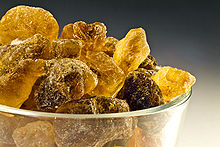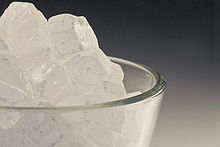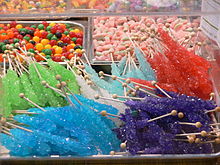Rock candy


Rock candy (also called rock sugar) is a type of confectionery composed of relatively large sugar crystals. Homemade rock candy is commonly formed by allowing a supersaturated solution of sugar and water to crystallize onto a string or some other surface suitable for crystal nucleation. Heating the water before adding the sugar allows more sugar to dissolve and thus produces larger crystals. Crystals form after several days. Food coloring may be added to the mixture to produce colored candy.
Origins

Candied sugar has its origins in India and Iran. Arabic writers in the first half of the 9th century described the production of candy sugar. Crystals were grown as a result of cooling supersaturated sugar solutions. In order to accelerate crystallization, confectioners later learned to immerse small twigs in the solution for the crystals to grow on. The sugar solution was colored with cochineal and indigo and scented with ambergris or flower essence.[1]
In cuisine


Rock candy is a different product from British rock, also called seaside rock, which more closely resembles a candy cane. In the Netherlands, in Western Frisia bits of rock candy are baked in a special type of luxury version of white bread called sugarbread.
Rock candy is also used to sweeten tea and is an important part of the tea culture of East Frisia (Germany).
In Hungary rock candies is called kandiszcukor, and are sold in candy shops as a regular candy, often as several candy chunks crystallized on a white string. Kandiszcukor may also be used in tea.[2]
Rock candy is used in Chinese cuisine. It is used to sweeten tong sui (sweet soups) and chrysanthemum tea, as well as Chinese liquors.
Rock candy is called mishri in Hindi and is widely used in India with aniseed (saunf in Hindi) as a mouth freshener, especially after meals. In Telugu, it is known as patika-bellam. One can find these two being offered along with the check/bill, at most[verification needed] restaurants in India. Rock candy is called kalkandu in Tamil and is commonly used in Tamil cuisine especially in Jaffna (Northern Sri Lanka). It is called Khadi Sakhar in Marathi. It is called Gula Batu in Indonesian. It is known to be effective in relieving cough.
Rock candy is also used in Mexico to make calaveras de azúcar ("sugar skulls") on the celebration of the Day of the Dead. Children make the rock candy in the shapes of skulls by special strings and then decorate them with icing and jewels. These candies are eaten after the festivities.
References
External links
- Exploratorium.edu Recipe for rock candy as an educational exercise in crystal
